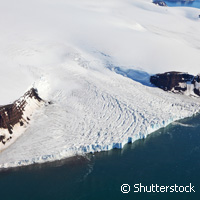Oct 6 2010
An international team of scientists has discovered nanosize diamonds in the Greenland ice sheet, according to a study presented in the Journal of Glaciology. The diamonds, which number in the trillions and are so tiny that they can only be observed with special, highly magnifying microscopes, add credence to the controversial hypothesis that fragments of a comet struck North America and Europe approximately 12 900 years ago.
'There is a layer in the ice with a great abundance of diamonds,' said co-author James Kennett, Professor Emeritus in the Department of Earth Science at the University of California (UC) in Santa Barbara, US. 'Most exciting to us is that this is the first such discrete layer of diamonds ever found in glacial ice anywhere on Earth, including the huge polar ice sheets and the alpine glaciers,' added the scientist, who is considered by many of his peers to be an early founder of marine geology and paleoceanography.

This discovery supports earlier published evidence for a cosmic impact event nearly 13,000 years ago, Professor Kennett explained. Last year, the scientist reported the discovery of nanosize diamonds in a layer of sediment exposed on Santa Rosa Island, off the coast of Santa Barbara in California in two papers published in the journals Proceedings of the National Academy of Sciences (PNAS) and Science.
A high proportion of the nanosize diamonds in the Greenland ice sheet exhibit hexagonal mineral structure, and these are only known to occur on Earth in association with known cosmic impact events, he said. This layer of diamonds corresponds with the sedimentary layer known as the Younger Dryas Boundary, dating to 12,900 years ago.
Professor Kennett explained that the layer containing nanodiamonds on Santa Rosa Island and those in the Greenland ice sheet appear to correspond closely to the time of the disappearance of the Clovis culture, the earliest well-established and well-accepted human culture living across North America.
The event also corresponds with the time of extinction of many large animals across the region, including mammoths, camels, horses, and the saber tooth cat. Moreover, there is evidence of widespread wildfires at that time and an associated sharp climatic cooling called the Younger Dryas is also recorded widely over the northern hemisphere, according to Professor Kennett. The cause of this cooling and the cause of the animal extinctions and human cultural shift have long been debated.
Professor Kennett pointed out that these findings merely represented a 'preliminary study' and that while the discovery of a potential postglacial peak in nanodiamonds in the Greenland ice sheet was 'exciting', he acknowledged that several 'unanswered questions' had arisen.
He said he was presenting this research now 'to stimulate further investigation and debate', suggesting, for example, that different types of sampling needed to be used in further studies. 'This study was undertaken using Greenland ice samples taken at relatively coarse resolution, and, to significantly refine the findings presented here, higher resolution sampling is needed,' the authors said in their paper.
Further areas of potential exploration should include more precise dating, more detailed geochemical time-series measurements including for the elements osmium and iridium, and the use of improved diamond-extraction procedures 'to minimise acid-resistant amorphous carbon', which they noted 'currently limits available analytical procedures'.
Expanded analyses of diamond allotropes, via, for instance Raman spectroscopy, a technique used to study vibrational, rotational, and other low-frequency modes, should also be carried out in the future, they noted.
Led by the University of Maine in the US, scientists from Denmark, Japan and the US also contributed to the study.
Source: Cordis